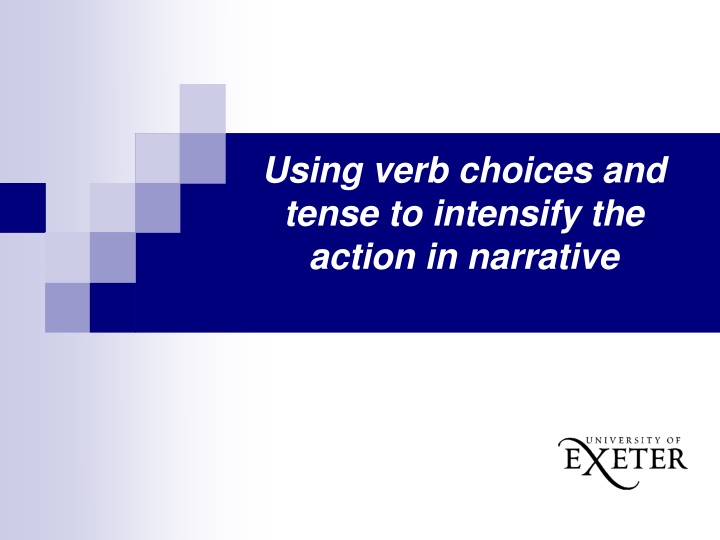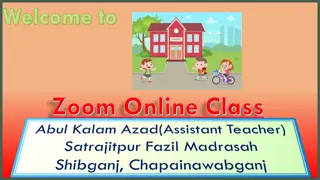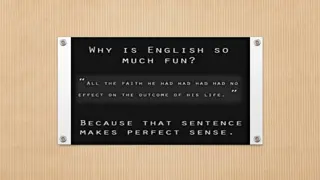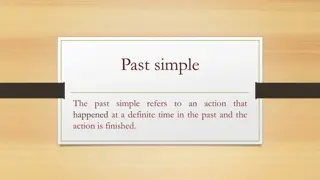Enhancing Narrative Intensity through Verb Choices and Tense
Explore the use of verb choices and tense to intensify the action in narratives. Discover how authors create vivid, powerful scenes through deliberate language selection. Learn the principles of LEAD to effectively connect grammar with meaning and writing. Analyze authentic texts to notice patterns and understand the impact of verb choices and tense on storytelling.
Download Presentation

Please find below an Image/Link to download the presentation.
The content on the website is provided AS IS for your information and personal use only. It may not be sold, licensed, or shared on other websites without obtaining consent from the author.If you encounter any issues during the download, it is possible that the publisher has removed the file from their server.
You are allowed to download the files provided on this website for personal or commercial use, subject to the condition that they are used lawfully. All files are the property of their respective owners.
The content on the website is provided AS IS for your information and personal use only. It may not be sold, licensed, or shared on other websites without obtaining consent from the author.
E N D
Presentation Transcript
Using verb choices and tense to intensify the action in narrative
LEAD Principles PRINCIPLE LINKS EXPLANATION RATIONALE To establish a purposeful learning reason for addressing grammar, and connect grammar with meaning and rhetorical effect Make a link between the grammar being introduced and how it works in the writing being taught To avoid writing lessons becoming mini- grammar lessons, and to allow access to the structure even if the grammar concept is not fully understood To integrate reading and writing and show how real writers make language choices EXAMPLES Explain the grammar through examples, not lengthy explanations AUTHENTIC TEXTS Use authentic texts as models to link writers to the broader community of writers To promote deep metalinguistic learning about why a particular choice works, and to develop independence rather than compliance DISCUSSION Build in high-quality discussion about grammar and its effects
Noticing Patterns in a Text Authentic text The gas is only feet away now. Through a yellow mist I see the trench filling up with it. It drifts into the dugouts, snaking into every nook and cranny, looking for me. It wants to see us all out, to kill us all, every one of us. Still I do not breathe. I see men running, staggering, falling. I hear Pete shouting out for me. Then he s grabbing me and we run. Half- blinded by my mask I trip and fall, crashing my head against the trench wall, knocking myself half- senseless. My eyes are stinging. My lungs are burning. I am coughing, choking, retching. Discussion The writer is describing a gas attack on soldiers in the First World War. How does he make this event sound so sudden, dramatic, frightening and painful?
Noticing Patterns in a Text Examples The gas is only feet away now. Through a yellow mist I see the trench filling up with it. It drifts into the dugouts, snaking into every nook and cranny, looking for me. It wants to see us all out, to kill us all, every one of us. Still I do not breathe. I see men running, staggering, falling. I hear Pete shouting out for me. Then he s grabbing me and we run. Half- blinded by my mask I trip and fall, crashing my head against the trench wall, knocking myself half- senseless. My eyes are stinging. My lungs are burning. I am coughing, choking, retching. Discussion Why do you think the writer uses so many verbs to describe the gas attack? Why do you think the writer has chosen to use the present tense, rather than the past tense? What difference does it make?
Noticing Patterns in a Text Examples The gas is only feet away now. Through a yellow mist I see the trench filling up with it. It drifts into the dugouts, snaking into every nook and cranny, looking for me. It wants to see us all out, to kill us all, every one of us. Still I do not breathe. I see men running, staggering, falling. I hear Pete shouting out for me. Then he s grabbing me and we run. Half- blinded by my mask I trip and fall, crashing my head against the trench wall, knocking myself half- senseless. My eyes are stinging. My lungs are burning. I am coughing, choking, retching. Discussion Why do you think the writer uses so many present tense verbs that end in ing? Do these affect how you see or hear the scene being described?
Verbalising the Grammar-Writing Link A crucial element of the LEAD principles is helping writers to think explicitly (metalinguistically) about the choices they make. As a teacher, you need to support this by being crystal clear yourself about how you verbalise the link between a grammar choice and its effect in a particular text/context. Then express this in student-friendly language, as below. Verbalisation to share with students: When you are writing narrative, you can think about how to emphasise the drama and pace of key action scenes. Choosing descriptive (lexical) verbs carefully and experimenting with verb tenses can help you do this.
Noticing Patterns in a Text Authentic text A machine gun opens up behind us and then rifles fire. There is nowhere to hide, so we pretend to be dead. We wait till the light dies and the night is suddenly black again. Wilkie gets us to our feet and we go on, running, stumbling, until more lights go up, and the machine gunners start up again. We dive into a crater and roll down crashing through the ice into the watery bottom. Then the shelling starts. It seems as if we have woken up the entire German army. I cower in the stinking water with the German and Charlie, the three of us clinging together, heads buried in one another as the shells fall all about us. Our own guns are answering now but it is little comfort to us. Charlie and I drag the Hun prisoner out of the water. Either he is talking to himself or he s saying a prayer, it s difficult to tell. Discussion Can you make this incident any more immediate and dramatic for the reader? Experiment with lexical verb choices in the present tense and compare your version with the original, explaining some of the changes made and what you wanted to achieve.























